Salon • Inspiration
Hair Is Political: Brush Up on Black Hair History

By Shanalie Wijesinghe . Feb.01.2022
Share Article
Black hair is a political issue, especially in the United States. We reflect on this in honor of Black History Month.
Black hair isn’t “just hair.” It’s a means of self expression. For many, it’s a strong signifier of identity. And it has a fraught political and historical legacy. As salon owners, it’s crucial that you understand the significance of Black hair. To do that, you need to know the history behind the identity issues and discrimination that many Black people face because of their hair. In this article, we’ll go over the history of Black hair and discrimination in the United States.
Slavery
When enslaved people were transported to America in the 1600s, one of the first things their captors did was shave their heads. Hair was (and still is) important to African communities — many people created intricate styles to signify a person’s class, wealth, and tribal affiliation. To remove an African person’s hair was, in many ways, an erasure of their identity.
Enslaved people were innovative when it came to caring for their hair on foreign soil. They no longer had access to the tools they used to care for their hair back in Africa. So they created combs, conditioners, and shampoos from materials at their disposal.
Enslaved people also felt pressure to conform to European beauty standards. That same pressure would continue to affect Black beauty for centuries. Many enslaved people found ways to straighten and style their hair to mimic and assimilate with white culture. Though now enhanced by modern technology, these same practices continue today.
Civil rights and beyond
Relaxers, products that chemically straighten your hair, became popular during the 1950s, and many people still use them today. However, by the 1960s, the Civil Rights Movement had begun to shift the narrative around blackness. Malcolm X urged Black people to reclaim their African identities; the term “African American” entered the common lexicon for the first time in history. Many African Americans decided to start wearing their hair in its natural state, inspiring a natural hair movement to begin. Activists like Angela Davis, who wore an afro, inspired many to ditch hot combs and relaxers and wear their curls proudly.
In the 1970s, one of the first natural hair discrimination cases went to the US Court of Appeals. In Jenkins vs. Blue Cross Mutual Hospital Insurance, a woman was denied a promotion at work because she wore an afro. The US Court of Appeals ruled that under Title VII of the Civil Rights Act, employees were entitled to have natural hair in the workplace.
Discrimination against African Americans in the workplace for their hairstyles did not end with that ruling. In 2010, Chastity Jones was hired for a customer service job in Alabama. After offering Jones the job, her employer demanded that she remove her dreadlocks, and referring to them as “dirty.” When Jones refused to do so, the employer rescinded the job offer. Jones sued the company unsuccessfully.
These are just two examples of instances where workplaces discriminated against people with Black hairstyles. Unfortunately hair-based discrimination is endemic to all US institusions, including schools.
The CROWN Act
The Create a Respectful and Open World for Natural Hair (CROWN) Act was introduced in 2019 to combat race-based hair discrimination in public schools and the workplace. It has been passed by the US House of Representatives but is still awaiting approval by the Senate. However, 12 states have passed the law or some variation of it while several others are in the pre-filing stages.
How can you help? You can support the CROWN Act by calling your senator and joining thousands of other people who have signed a petition to pass the law at the federal level. Visit thecrownact.com to learn more about the act.
Boulevard was built to help your business achieve profitability at scale without losing an inch of sanity. See for yourself! Get a free demo today.
Sign up for weekly blog updates.
